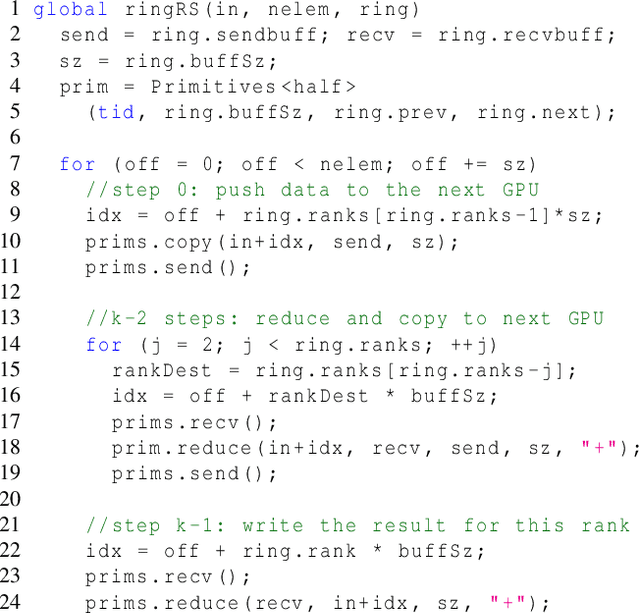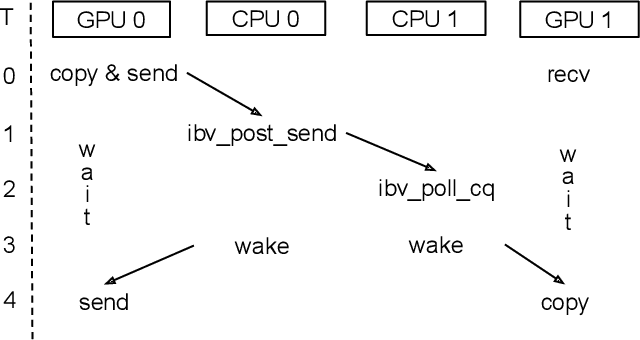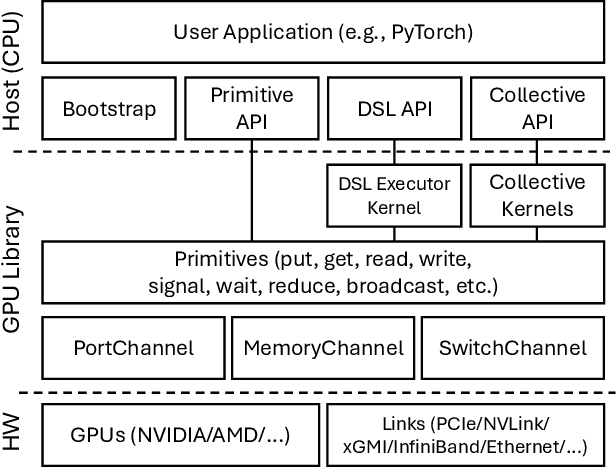Peng Cheng
Zhejiang University, Hangzhou, China
Recycling Pretrained Checkpoints: Orthogonal Growth of Mixture-of-Experts for Efficient Large Language Model Pre-Training
Oct 09, 2025Abstract:The rapidly increasing computational cost of pretraining Large Language Models necessitates more efficient approaches. Numerous computational costs have been invested in existing well-trained checkpoints, but many of them remain underutilized due to engineering constraints or limited model capacity. To efficiently reuse this "sunk" cost, we propose to recycle pretrained checkpoints by expanding their parameter counts and continuing training. We propose orthogonal growth method well-suited for converged Mixture-of-Experts model: interpositional layer copying for depth growth and expert duplication with injected noise for width growth. To determine the optimal timing for such growth across checkpoints sequences, we perform comprehensive scaling experiments revealing that the final accuracy has a strong positive correlation with the amount of sunk cost, indicating that greater prior investment leads to better performance. We scale our approach to models with 70B parameters and over 1T training tokens, achieving 10.66% accuracy gain over training from scratch under the same additional compute budget. Our checkpoint recycling approach establishes a foundation for economically efficient large language model pretraining.
Training Matryoshka Mixture-of-Experts for Elastic Inference-Time Expert Utilization
Sep 30, 2025Abstract:Mixture-of-Experts (MoE) has emerged as a promising paradigm for efficiently scaling large language models without a proportional increase in computational cost. However, the standard training strategy of Top-K router prevents MoE models from realizing their full potential for elastic inference. When the number of activated experts is altered at inference time, these models exhibit precipitous performance degradation. In this work, we introduce Matryoshka MoE (M-MoE), a training framework that instills a coarse-to-fine structure directly into the expert ensemble. By systematically varying the number of activated experts during training, M-MoE compels the model to learn a meaningful ranking: top-ranked experts collaborate to provide essential, coarse-grained capabilities, while subsequent experts add progressively finer-grained detail. We explore this principle at multiple granularities, identifying a layer-wise randomization strategy as the most effective. Our experiments demonstrate that a single M-MoE model achieves remarkable elasticity, with its performance at various expert counts closely matching that of an entire suite of specialist models, but at only a fraction of the total training cost. This flexibility not only unlocks elastic inference but also enables optimizing performance by allocating different computational budgets to different model layers. Our work paves the way for more practical and adaptable deployments of large-scale MoE models.
Reasoning on a Budget: A Survey of Adaptive and Controllable Test-Time Compute in LLMs
Jul 02, 2025Abstract:Large language models (LLMs) have rapidly progressed into general-purpose agents capable of solving a broad spectrum of tasks. However, current models remain inefficient at reasoning: they apply fixed inference-time compute regardless of task complexity, often overthinking simple problems while underthinking hard ones. This survey presents a comprehensive review of efficient test-time compute (TTC) strategies, which aim to improve the computational efficiency of LLM reasoning. We introduce a two-tiered taxonomy that distinguishes between L1-controllability, methods that operate under fixed compute budgets, and L2-adaptiveness, methods that dynamically scale inference based on input difficulty or model confidence. We benchmark leading proprietary LLMs across diverse datasets, highlighting critical trade-offs between reasoning performance and token usage. Compared to prior surveys on efficient reasoning, our review emphasizes the practical control, adaptability, and scalability of TTC methods. Finally, we discuss emerging trends such as hybrid thinking models and identify key challenges for future work towards making LLMs more computationally efficient, robust, and responsive to user constraints.
ImprovDML: Improved Trade-off in Private Byzantine-Resilient Distributed Machine Learning
Jun 18, 2025Abstract:Jointly addressing Byzantine attacks and privacy leakage in distributed machine learning (DML) has become an important issue. A common strategy involves integrating Byzantine-resilient aggregation rules with differential privacy mechanisms. However, the incorporation of these techniques often results in a significant degradation in model accuracy. To address this issue, we propose a decentralized DML framework, named ImprovDML, that achieves high model accuracy while simultaneously ensuring privacy preservation and resilience to Byzantine attacks. The framework leverages a kind of resilient vector consensus algorithms that can compute a point within the normal (non-Byzantine) agents' convex hull for resilient aggregation at each iteration. Then, multivariate Gaussian noises are introduced to the gradients for privacy preservation. We provide convergence guarantees and derive asymptotic learning error bounds under non-convex settings, which are tighter than those reported in existing works. For the privacy analysis, we adopt the notion of concentrated geo-privacy, which quantifies privacy preservation based on the Euclidean distance between inputs. We demonstrate that it enables an improved trade-off between privacy preservation and model accuracy compared to differential privacy. Finally, numerical simulations validate our theoretical results.
Robust Transceiver Design for RIS Enhanced Dual-Functional Radar-Communication with Movable Antenna
Jun 09, 2025Abstract:Movable antennas (MAs) have demonstrated significant potential in enhancing the performance of dual-functional radar-communication (DFRC) systems. In this paper, we explore an MA-aided DFRC system that utilizes a reconfigurable intelligent surface (RIS) to enhance signal coverage for communications in dead zones. To enhance the radar sensing performance in practical DFRC environments, we propose a unified robust transceiver design framework aimed at maximizing the minimum radar signal-to-interference-plus-noise ratio (SINR) in a cluttered environment. Our approach jointly optimizes transmit beamforming, receive filtering, antenna placement, and RIS reflecting coefficients under imperfect channel state information (CSI) for both sensing and communication channels. To deal with the channel uncertainty-constrained issue, we leverage the convex hull method to transform the primal problem into a more tractable form. We then introduce a two-layer block coordinate descent (BCD) algorithm, incorporating fractional programming (FP), successive convex approximation (SCA), S-Lemma, and penalty techniques to reformulate it into a series of semidefinite program (SDP) subproblems that can be efficiently solved. We provide a comprehensive analysis of the convergence and computational complexity for the proposed design framework. Simulation results demonstrate the robustness of the proposed method, and show that the MA-based design framework can significantly enhance the radar SINR performance while achieving an effective balance between the radar and communication performance.
Skywork Open Reasoner 1 Technical Report
May 29, 2025Abstract:The success of DeepSeek-R1 underscores the significant role of reinforcement learning (RL) in enhancing the reasoning capabilities of large language models (LLMs). In this work, we present Skywork-OR1, an effective and scalable RL implementation for long Chain-of-Thought (CoT) models. Building on the DeepSeek-R1-Distill model series, our RL approach achieves notable performance gains, increasing average accuracy across AIME24, AIME25, and LiveCodeBench from 57.8% to 72.8% (+15.0%) for the 32B model and from 43.6% to 57.5% (+13.9%) for the 7B model. Our Skywork-OR1-32B model surpasses both DeepSeek-R1 and Qwen3-32B on the AIME24 and AIME25 benchmarks, while achieving comparable results on LiveCodeBench. The Skywork-OR1-7B and Skywork-OR1-Math-7B models demonstrate competitive reasoning capabilities among models of similar size. We perform comprehensive ablation studies on the core components of our training pipeline to validate their effectiveness. Additionally, we thoroughly investigate the phenomenon of entropy collapse, identify key factors affecting entropy dynamics, and demonstrate that mitigating premature entropy collapse is critical for improved test performance. To support community research, we fully open-source our model weights, training code, and training datasets.
OSS-UAgent: An Agent-based Usability Evaluation Framework for Open Source Software
May 29, 2025Abstract:Usability evaluation is critical to the impact and adoption of open source software (OSS), yet traditional methods relying on human evaluators suffer from high costs and limited scalability. To address these limitations, we introduce OSS-UAgent, an automated, configurable, and interactive agent-based usability evaluation framework specifically designed for open source software. Our framework employs intelligent agents powered by large language models (LLMs) to simulate developers performing programming tasks across various experience levels (from Junior to Expert). By dynamically constructing platform-specific knowledge bases, OSS-UAgent ensures accurate and context-aware code generation. The generated code is automatically evaluated across multiple dimensions, including compliance, correctness, and readability, providing a comprehensive measure of the software's usability. Additionally, our demonstration showcases OSS-UAgent's practical application in evaluating graph analytics platforms, highlighting its effectiveness in automating usability evaluation.
FedSaaS: Class-Consistency Federated Semantic Segmentation via Global Prototype Supervision and Local Adversarial Harmonization
May 14, 2025Abstract:Federated semantic segmentation enables pixel-level classification in images through collaborative learning while maintaining data privacy. However, existing research commonly overlooks the fine-grained class relationships within the semantic space when addressing heterogeneous problems, particularly domain shift. This oversight results in ambiguities between class representation. To overcome this challenge, we propose a novel federated segmentation framework that strikes class consistency, termed FedSaaS. Specifically, we introduce class exemplars as a criterion for both local- and global-level class representations. On the server side, the uploaded class exemplars are leveraged to model class prototypes, which supervise global branch of clients, ensuring alignment with global-level representation. On the client side, we incorporate an adversarial mechanism to harmonize contributions of global and local branches, leading to consistent output. Moreover, multilevel contrastive losses are employed on both sides to enforce consistency between two-level representations in the same semantic space. Extensive experiments on several driving scene segmentation datasets demonstrate that our framework outperforms state-of-the-art methods, significantly improving average segmentation accuracy and effectively addressing the class-consistency representation problem.
ArtistAuditor: Auditing Artist Style Pirate in Text-to-Image Generation Models
Apr 17, 2025Abstract:Text-to-image models based on diffusion processes, such as DALL-E, Stable Diffusion, and Midjourney, are capable of transforming texts into detailed images and have widespread applications in art and design. As such, amateur users can easily imitate professional-level paintings by collecting an artist's work and fine-tuning the model, leading to concerns about artworks' copyright infringement. To tackle these issues, previous studies either add visually imperceptible perturbation to the artwork to change its underlying styles (perturbation-based methods) or embed post-training detectable watermarks in the artwork (watermark-based methods). However, when the artwork or the model has been published online, i.e., modification to the original artwork or model retraining is not feasible, these strategies might not be viable. To this end, we propose a novel method for data-use auditing in the text-to-image generation model. The general idea of ArtistAuditor is to identify if a suspicious model has been finetuned using the artworks of specific artists by analyzing the features related to the style. Concretely, ArtistAuditor employs a style extractor to obtain the multi-granularity style representations and treats artworks as samplings of an artist's style. Then, ArtistAuditor queries a trained discriminator to gain the auditing decisions. The experimental results on six combinations of models and datasets show that ArtistAuditor can achieve high AUC values (> 0.937). By studying ArtistAuditor's transferability and core modules, we provide valuable insights into the practical implementation. Finally, we demonstrate the effectiveness of ArtistAuditor in real-world cases by an online platform Scenario. ArtistAuditor is open-sourced at https://github.com/Jozenn/ArtistAuditor.
MSCCL++: Rethinking GPU Communication Abstractions for Cutting-edge AI Applications
Apr 11, 2025



Abstract:Modern cutting-edge AI applications are being developed over fast-evolving, heterogeneous, nascent hardware devices. This requires frequent reworking of the AI software stack to adopt bottom-up changes from new hardware, which takes time for general-purpose software libraries. Consequently, real applications often develop custom software stacks optimized for their specific workloads and hardware. Custom stacks help quick development and optimization, but incur a lot of redundant efforts across applications in writing non-portable code. This paper discusses an alternative communication library interface for AI applications that offers both portability and performance by reducing redundant efforts while maintaining flexibility for customization. We present MSCCL++, a novel abstraction of GPU communication based on separation of concerns: (1) a primitive interface provides a minimal hardware abstraction as a common ground for software and hardware developers to write custom communication, and (2) higher-level portable interfaces and specialized implementations enable optimization for different hardware environments. This approach makes the primitive interface reusable across applications while enabling highly flexible optimization. Compared to state-of-the-art baselines (NCCL, RCCL, and MSCCL), MSCCL++ achieves speedups of up to 3.8$\times$ for collective communication and up to 15\% for real-world AI inference workloads. MSCCL++ is in production of multiple AI services provided by Microsoft Azure, and is also adopted by RCCL, the GPU collective communication library maintained by AMD. MSCCL++ is open-source and available at https://github.com/microsoft/mscclpp.
 Add to Chrome
Add to Chrome Add to Firefox
Add to Firefox Add to Edge
Add to Edge